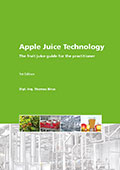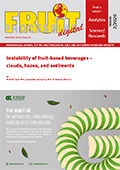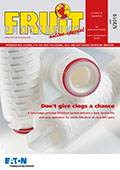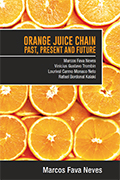The dry and warm weather in São Paulo concerned citrus growers in early May. They say that fruits were falling from the trees, a scenario that is reinforced in areas with high incidence of HLB (Huanglongbing, or greening).
Growers collected fruits that fell, allocating them to crushing activities, although this process is more expensive than the regular harvest. Still, as prices at factories are high, this fact ends up being advantageous for both citrus growers and the industry, which needs to absorb as more fruits as possible. It is worth noting that higher temperatures and below-average rains since the middle of the second semester last year may result in a lower volume to harvest in 2024/25.
The heat wave and the lack of rains also affect the quality of oranges, reducing its attractiveness in the market.
As for the tahiti lime, the dry weather started to affect the development and the quality of the peel. Some producers were concerned and started harvesting, aiming to collect fruits that are prematurely falling to send them immediately to the industry.
In 2024, orange prices paid to citrus growers in São Paulo/Triângulo Mineiro may remain at high levels. The supply may continue to be lower than the industrial demand, keeping the availability limited in the in natura market.
So far, there are no solid aspects that allow to project the volume that will be harvested in the 2024/25 season; however, the orange juice supply may not be enough to meet the demand, especially because of the expectation of low juice stocks in June 2024.
CitrusBR says that the volume in stocks by the end of the 2022/23 season (in June/23) was only 84.745 thousand tons equivalent to concentrate juice. Cepea calculations based on the orange production forecast by Fundecitrus indicate that the volume in stocks by the end of the current season (2023/24, in June/24) may not be higher. This scenario may be reinforced in case exports continue intense and the productivity remains below-average.
Therefore, it would be important if the orange volume harvested in São Paulo and in Triângulo Mineiro is above the average over the last years in order for the processed volume to meet exports and allow a recovery in stocks by June 2025. However, challenges faced in the second semester of 2023 (greening and heat waves) may bring difficulties for a good harvest in 2024/25.
It is worth noting that Brazil does not have major competitors regarding the global orange juice supply. Mexico, an important supplier for the US market, has been facing difficulties in the production, especially because of the dry weather, while Florida has been facing the impacts of greening. In this scenario, a decrease in the Brazilian availability might affect the world orange juice supply.
Investments
Although the profitability scenario had been positive in 2023, major investments in São Paulo are not expected for 2024, due to the high incidence of greening. The planting can continue firm in Triângulo Mineiro, but the availability of soil and water for irrigation are limited.
A pair of Quintus Technologies High Pressure Processing (HPP) systems will begin operation in Yiqing Food’s new beverage facility in Danjiangkou, Hubei province, China, later this year. Manufactured at Quintus’s state-of-the-art facility in Sweden, the presses are part of a customised turnkey solution provided by liquid packaging expert Jiangsu Newamstar Packaging Machinery Co., Ltd., with both presses scheduled for handover in Fourth Quarter 2023.
Focusing on integrated solutions for smart factories making liquid products, Newamstar selected the Quintus press model QIF 400L-6100, which features a very large vessel diameter of 18.5-inch (47 cm), for its high capacity, reliability, and lower per unit production cost. Each press will perform 10 cycles per hour to meet Yiqing Food’s target of 18,000 bottles of fresh juice per hour.
High Pressure Processing is the ground-breaking food safety technology that uses pressure instead of chemicals and heat to inactivate dangerous foodborne pathogens without compromising the quality or taste of the end product. HPP significantly extends refrigerated shelf life, producing preservative-free foods and beverages that retain their full nutritional benefits.
Yiqing Food, a state-owned food conglomerate, is one of the largest domestic soft drink producers in China. Its new modern and highly automated plant in Danjiangkou includes a premium juice production line that integrates high pressure processing of its upscale mandarin orange juice.
“The Chinese market is seeing a growing demand for HPP products, as processors seek to bolster food safety and brand protection while consumers grow increasingly concerned with healthy, nutritious eating,” says James He, Newamstar’s Chief Executive Officer. “Consumers appreciate the value of fresh, high-end fruit juices and teas that undergo the HPP process, such as Yiqing’s popular mandarin orange juice, which will be made in the Danjiangkou facility.”
The global leader in high pressure technology, Quintus has long been active in the Chinese market, supporting its customers with a well-established service operation across the APAC region. The company opened a China office in January 2018 to better serve its local customers.
The QIF 400L press family incorporates advanced features like frequency-controlled motor drives for energy conservation; “SmartPress” cloud-based press management software; fewer moving parts for reduced downtime; and easy access to all components requiring regular maintenance or inspection. The press’s wire-wound frame and cylinder design for safety and lighter weight reflect Quintus’s legacy as the HPP pioneer.
“These high-performing solutions illustrate how Quintus has maintained the lead in high pressure for almost 75 years,” Mr. He comments.“The QIF 400L presses are supported by a long legacy and meet Yiqing’s needs seamlessly. It is important for us to select the best quality equipment to meet our customers’ demanding specifications.”
“The new generation of Quintus HPP systems helps processors boost production efficiencies through high system availability and controlled service costs,” Jan Söderström, CEO and President of Quintus Technologies, points out. “We are pleased to embark on this new partnership with Newamstar and look forward to working with them as Yiquing Food continues on its growth trajectory,” he concludes.
Tahiti lime prices faded in São Paulo State in the first fortnight of March. According to Cepea collaborators, the current hot weather in Brazil has been favoring consumption, however, supply is high, due to the peak of harvest. Thus, quotations were pressed down.
However, many farmers reported that supply is beginning to decrease. The harvesting, which has been in full swing since mid-January, is expected to slow down until the end of March.
During the peak of harvest in 2022 (January – March), the quotations for tahiti lime have been lower than that in the same period of 2021. From the beginning of the year until March 10th, the average price for this variety closed at BRL 21.92/box, harvested, 1.8 % down from that in the first quarter of 2021, in nominal terms. Only in January/22 prices were higher than that in Jan/21.
The lower volume to be harvested in the coming weeks is expected to limit processing. By the end of the first fortnight, four plants were operating in SP, paying from BRL 18 to BRL 20.00 per 27-kilo box, harvested and delivered to processors.
EXPORTS – Brazilian exports of lemon and lime have been high this year. According to Secex, in the first two months of 2022, Brazil shipped to all destinations 22 thousand tons of lemons and limes, 17.1 % up from that in the same period last year, only lower than that in the first bimester of 2020. Revenue total USD 17.3 million, 11.9 % up in the same comparison. Despite higher volume and revenue, the average price (in dollar) paid for the fruit is lower than that from the same period of 2021.
In February, exports performance was a record for the month, favored by high supply in SP and higher quality of the fruits (because of recent rainfall). According to Secex, Brazil shipped 11.8 thousand tons of lemon and lime in February, 13.4 % up from that in Feb/21. Revenue totaled USD 9.2 million, 9.5 % up, in the same comparison.
The global cold pressed juice market is segmented by category into conventional and organic; by type into fruits, vegetables and blends; by distribution channels into store based and non-store based and by regions. The global cold pressed juice market is estimated to grow at a CAGR of around 10 % over the forecast period i.e. 2019-2027.
The cold pressed juice market is anticipated to maintain a significant growth rate on the back of rising disposable income levels, awareness among consumers concerning healthy food & drinks, and easy availability of cold pressed juices. On the basis of category, cold pressed juice market is segmented into conventional and organic. Out of which organic is expected to be dominant segment as a result of shifting trends towards consummation of organic juices and increasing per capita income in developing economies across the globe.
North America cold pressed juice market is anticipated to witness fast growth. This growth is attributed to the rise in the implementation of latest technologies in packaged food & beverages industry, changing lifestyle of consumers, and existence of well-established industrial infrastructure in the region. Growing awareness among consumers regarding health benefits of sugar-free and organic juices are some another factors that drives the growth of regional market.
Growing Concerns Regarding Various Health Issues
Growing concerns regarding various health issues, while simultaneously growing number of health benefits associated with consuming cold pressed juices are estimated to boost the growth of cold pressed juice market. Rising health awareness among consumers is gradually causing a shift towards the consumption of beverages that are calorie-free, caffeine-free, and free from artificial ingredients. Numerous factors such as changing lifestyle, changing food patterns, and rising health consciousness among younger section of the society are likely to result in considerable growth of cold pressed juice market during the forecast period.
However, use of organic flavors and adoption of the high pressure processing (HPP) manufacturing processes, makes them expensive. Thus, in terms of cost, cold pressed juices are anticipated to witness significant hindrance in term of the market growth in comparison to its substitutes.
The report titled “Cold pressed juice Market: Global Demand Analysis & Opportunity Outlook 2027” delivers detailed overview of the cold pressed juice market in terms of market segmentation by category, by type, by distribution channels and by regions.
Further, for the in-depth analysis, the report encompasses the industry growth drivers, restraints, supply and demand risk, market attractiveness, BPS analysis and Porter’s five force model.
This report also provides the existing competitive scenario of some of the key players of the global cold pressed juice market which includes company profiling of Coca Cola / Odwalla, Hain Blue Print Inc., Starbucks / Evolution Fresh, Suja Life, LLC, Pressed Juicery, Juice Generation, Florida Bottling, Drink Daily Greens, Liquiteria and Other Prominent Players. The profiling enfolds key information of the companies which encompasses business overview, products and services, key financials and recent news and developments. On the whole, the report depicts detailed overview of the global cold pressed juice market that will help industry consultants, equipment manufacturers, existing players searching for expansion opportunities, new players searching possibilities and other stakeholders to align their market centric strategies according to the ongoing and expected trends in the future.
Global roll-out underway of largest production-volume addition to Unifiller range, a system that features an accuracy rate typically double those of competitors.
JBT Corporation, one of the world’s leading solutions providers for the food and beverage processing industries, is pleased to announce the launch of the new, High Capacity Unifiller, a unit capable of filling 1,500 containers per minute at an unparalleled accuracy rate.
The High Capacity Unifiller, which can be synchronized with JBT’s 12-head seamer to provide an effective, high-speed canning solution, includes all the best features required for Total Performance Management (TPM), such as clear-guarding, enabling easy revision of the machine as it functions, and LED lighting. The system’s built-in Clean-In-Place (CIP) technology also means the system can be completely cleaned in around one hour, maximizing uptime and minimizing downtime in the process.
Jan Sundberg, JBT’s Produce Line Manager for the Americas, said: “When you have lines that are dedicated to one can- or container-size in high volume, this is a good fit. Eliminating older lines and combining them into a single line can improve efficiency and achieve cost reductions. If you look at the cost per container compared with a single high speed line, there are some big savings. If customers have to achieve the volume, this is the best way of doing it.”
Sundberg added that the High Capacity Unifiller also features an accuracy rate typically double those of competitors. “This adds up very quickly on high-speed lines like this,” he said. “If you are running 1,000+ cans per minute, we are talking about several hundred thousand dollars a year in savings.” To date, JBT has sold and installed four High Capacity Unifillers – two in Asia-Pacific, one in North America and one in South America. The new installations perform: high speed filling of Coffee Drinks in glass bottles, high speed canning of Evaporated Milk, and the fastest filling line of Sweetened Condensed Milk in the world.









